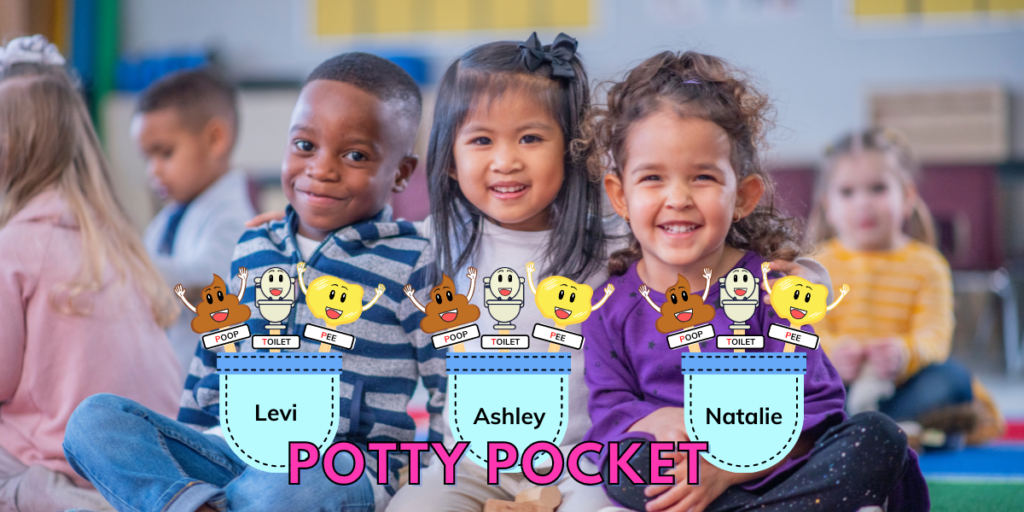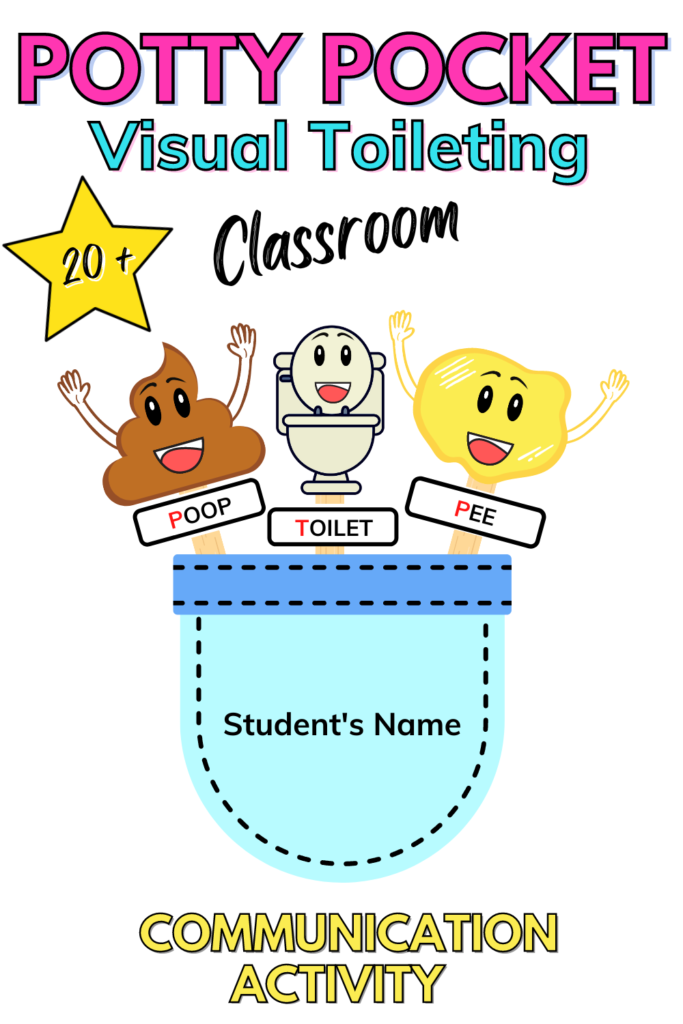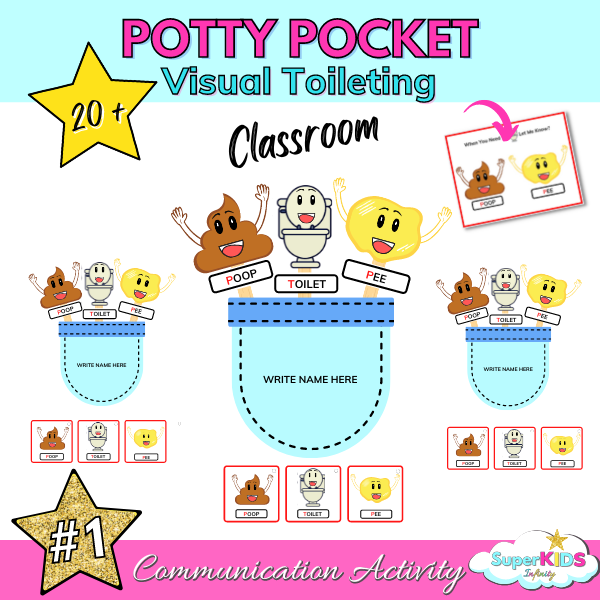
Potty Training Visuals for Special Education
Potty Pocket is the best special education classroom visual potty training activity that will encourage students “to let someone know when they need to go!!!” Many children especially toddlers have a fear of peeing and pooping in the toilet. Toddlers are the typical age to begin potty training and the transition from diapers to the toilet can be challenging. However, Potty Pocket encourages interaction to either raise the peep, poop, or toilet image high to the sky with excitement or use the image as visual cues to let you know when he or she needs to go. Potty Pocket is a great motivational toileting activity for early learners!!!
SuperMomInfinity is a participant in the Amazon Services LLC Associates Program, which is an affiliate advertising program designed to provide a means for sites to earn advertising fees by advertising and linking to Amazon.com. Please read my Disclosure for more details.
Classroom Potty Training Activity for Special Needs
Let’s get the whole classroom involved!!! Potty Pocket can be included in your daily lesson plan to motivate and encourage the whole class to become fearless and excited about going to the toilet. Toileting can be challenging for some students however, children have the tendency to mimic others and become motivated when the whole class is participating in the activity. Potty Pocket is here to help students with special needs who hide when they have to go, the students who have toileting fear and anxiety, and for students who need communication assistance. The ultimate goal for students using Potty Pocket is to prevent bashful bowel and bladder. Also to communicate the need of having to go!!!

Special Education Potty Training Resource
Potty Pocket was also designed for children with special needs. Students who are nonverbal, have speech and language delays, Autism, and Special Needs children will definitely enjoy The Potty Pocket Visual Communication Activity!!!
Toileting Activity for Non-Verbal Students
Students who are non-verbal can also practice pointing and holding up the images to communicate their toileting needs. Potty Pocket is definitely a fun potty training activity for all children. Potty Pocket motivates children to be excited about going! The goal of Potty Pocket is to eliminate bashful bowel/bladder whether it’s caused by fear or anxiety. Potty Pocket is excited to offer your students the assistance needed to communicate and motivate their toileting needs.
Autism Potty Training Communication Activity
Communication needs and wants for children with Autism can be a challenge for them. Potty Pocket is an assistive activity to practice and encourage communicating for specific elimination needs of the bowel and bladder. It’s also a fun activity to help your little ones feel fearless and excited about going to the toilet!!!
Speech Delay Potty Training Visuals
Potty Pocket is an awesome visual communication activity for any age child needed assistance to meet his or her toileting need!!! Potty Pocket can motivate children with speech and language delays to point or hold up an image when he or she needs to go. The repetition of hearing, viewing, and practicing sounds and words of the image can also encourage vocal pronunciation of the word, pee, poop, potty, and toilet!!!
Toileting Training Communication Poster
Your visual toileting communication activity includes an 11 x 8.5 Potty Poster you can adhere to the bathroom door. Encourage your little one to point to the pee or poop image on the poster. Pointing encourages nonverbal and speech-delayed children’s communication skills by letting you know their needs and wants. The Potty Training Poster offers visual repetition to help your child memorize the images, understand, and identify.
Visual Potty Cards
Potty visual cards that can be accessible for “on the go”. Making a wristlet out of the pee, poop, and toilet is a great idea you can use. The potty training visual wristlet will offer the additional repetition needed for the individual to grasp communicating his or her potty/toileting needs.
How To Use Potty Pocket?
Potty Pocket can adhere to an area your students mostly utilize. Their desk is the ideal place which is a convenient and easily accessible area students are located. It can be placed on the wall or on a table visible to the child as well. However, you will need to instruct your students on how to use Potty Pocket, and the best way to do so is to use the show, tell, and demonstration method.
Show your students the Potty Pocket and the 3 images attached to the popsicle stick. Also, orientate the class on how to insert and remove the popsicle sticks. Tell and explain each image to encourage your students’ understanding. Potty Pocket’s purpose is to build a potty communication system between you and students.
Now it’s time for your to demonstrate Potty Pocket’s use by acting out a scenario. Pretend you have to use the potty. First, you want to remove the pee image and point to the pee. Pointing is a communication strategy used for nonverbal and speech-delayed children.
Next, you’ll raise the pee image by the popsicle stick high to the high. Raising the images to the sky is an action informing the educator that the child needs to pee. This strategy is also a form of communication for special needs children.
Lastly, I recommend voicing the description of the image because continuous voicing and pronunciation can encourage your students to memorize the word. Students may hear the word pee and migrate to their potty area. This will let you know your class is understanding you and the word pee. Students will gradually begin to understand and identify all the images. Use the show, tell, and demonstration method for the visual wristlets and poster board too

Potty Training Printable Materials
Let’s put your potty pocket together!!! Here is a list of all the items and materials needed to create your very own Potty Pocket for your little one.
Hp Printer
As I ventured into creating printable learning binders and activities, I knew it was time to invest in a printer. Lol, it was an asset for my business and my current one only held black ink. I also tried another version of Hp, but it gave me a few complications. I then bought this Hp Printer and have been truly satisfied ever since.
Printing Potty Printables
Ok, I totally love Amazon and their products, but to be honest. I tried Neenah Bright White but the paper has a slight yellow tint to it. Neenah will do the job but I have a specific preference when it comes to cardstock paper. Amazon also has a brand I recently tried out called PrintWorks and I can say it’s acceptable for creating printables. PrintWorks cardstock is my second favorite!
Now my most recommendable cardstock paper is Pen Gear Cardstock at Walmart! The paper is thick and it holds the color of ink almost to the “T”. Sam’s Club also has a brand that I really like too, it’s the Exact Index, Cardstock.
Quick Note: Regular copy paper may alter the color quality of your printables. Some printers may also alter the color quality. The configuration of your printer may need to be run again if your color quality is not meeting your expectations. Office Depot is an optional printing service you can use for printing quality colors on cardstock paper.
Laminating Machine for Printables
To create a learning binder you will also need a laminating machine. I literally thought this investment was going to be expensive, but I can say it wasn’t and definitely gets the job done. Scotch Laminating Machines have been a part of my business for two years strong and never gave me any complications.
Laminating Pouches
Here are the thermal laminating sheets also needed to create printable activities. I have played around with quite a few different brands and these are my favorite. With both the laminating machine and sheets, I always slide the laminating pouches in twice just to make sure everything has adhered tightly together.
Scissors
Cutting out pieces for your printable requires scissors. Not saying a specific brand is better than the next, but it’s definitely a must-have. I like to have a few scissors nearby because it’s always something I’m looking for.
Jumbo Popsicle Sticks
Your potty training visuals for Potty Pocket require jumbo popsicle sticks to adhere to the back of the images and labels. The popsicle stick is accessible to most children and gives the child the opportunity to interact with the images. It’s also great for encouraging eye/hand coordination and fine motor development.
Hot Glue Gun
To adhere the images to the popsicle stick you will also need a hot glue gun to make Potty Pocket come to life!
Cord Hair Tie
Your Potty Pocket also includes 3 communication cards that are accessible for “on the go” and works great with the phone cord hair ties. Your children will be able to have the cards readily available on their little wrists for communicating their toileting needs.
Metal Book Ring
You will need one metal book ring per wristlet. Your potty visual wristlet is great to have for on the go.
Whole Puncher
No need to get fancy when it comes to a hole puncher lol, but you will need it to punch the holes in your 3 communication cards. You will punch out the little circles on the potty cards, add the keyring loop, attach the phone cord hair tie and your on-the-go communication visual cards are ready to be used.
Benefits of Potty Pocket
Visual Potty communication printable activity for kids. Fun interactive toilet training printable to encourage communication of bowel and bladder elimination and to prevent bashful toileting.
